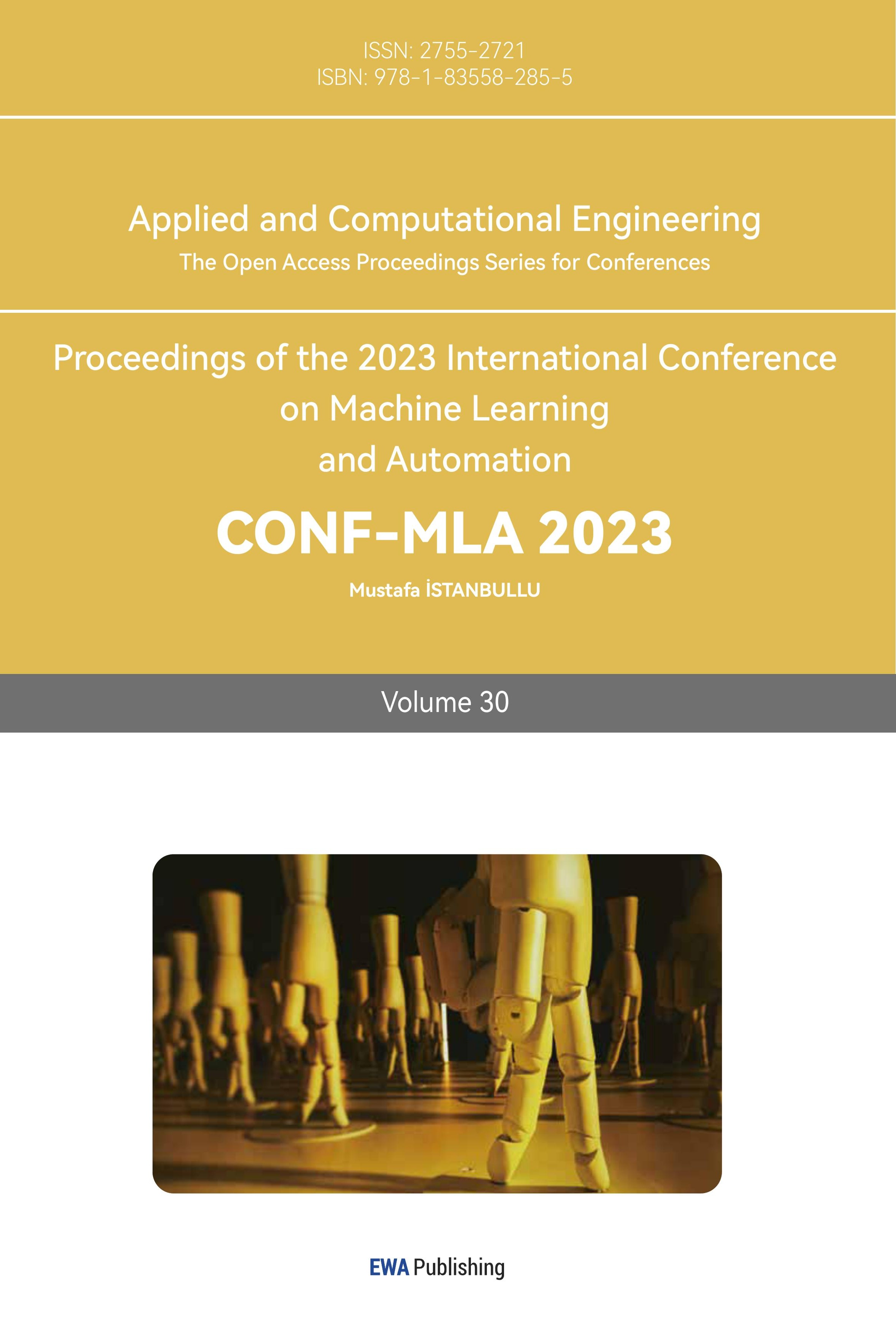References
[1]. Qin C C 2022 Research on heart disease prediction based on catboost model Qufu Normal University p 53 doi:10.27267/d.cnki.gqfsu.2022.001453.
[2]. Wang X 2022 Study on machine learning based heart disease prediction model Xinan Daxue p 57 doi:10.27684/d.cnki.gxndx.2022.001659.
[3]. Xin R H, Dong Z Y, Miao F B, Wang T T, Li Y R and Feng X 2022 Research on heart disease prediction model based on machine learning Jilin Huagong Xueyuan Xuebao 39(09) p 27-32 doi:10.16039/j.cnki.cn22-1249.2022.09.006.
[4]. Zheng L J and Song B 2023 Pre- Pruning and Optimization of Decision Tree Classification Algorithm Zidonghua Yibiao 44(05) p 56-62 doi: 10.16086/j.cnki.issn1000-0380.2023020066.
[5]. Kotsiantis S B 2013 Decision trees:a recent overview Artificial Intelligence Review 39(4) p 261-283 doi:10.1007/s10462-011-9272-4.
[6]. Zhao X M, Wei X J, Wang N and Lei X J 2020 Feature Aggregation Decision Tree Prediction Model for Rainfall Landslide Disaster J. Catastrophology 35(01) p 27-31
[7]. Baidya A, Pasha A, Pavani B R, Paul A and Wali A 2020 Comparative Analysis of Multiple classifiers for Heart Disease Classification International J. Advanced Research Comp. Sci. 11(3) p 6-11 doi:10.26483/ijarcs.v11i3.6523.
[8]. Liang J H and Xu Y J 2022 Research on Predictive Diagnosis Model of Heart Disease Based on Machine Learning Algorithm Modern Inf. Tech. 6(19) p 67-70 doi: 10.19850/j.cnki.2096-4706.2022.19.017.
[9]. Tang Y F, Ke Y B, Zhuang L Y, Ji R D, Chen J Z and Yu K H 2023 Pipelines Ultrasonic Guided Wave Classification Based on Confusion Matrix Neural Network Chinese J. Election Devices 46(02) p 469-477
[10]. Chicco D and Jurman G 2020 The advantages of the Matthews correlation coefficient (MCC)over F1 score and accuracy in binary classification evaluation BMC Genomics 21(6) p 4-5 doi:10.1186/s12864-019-6413-7.
[11]. Xing W C and Bei Y L 2020 Medical Health Big Data Classification Based on KNN Classification Algorithm IEEE Access 8(86) p 28808-28819 doi: 10.1109/access.2019.2955754.
Cite this article
Wang,Y. (2024). Application and comparison of decision tree algorithm and K-Nearest Neighbors algorithm in heart disease prediction. Applied and Computational Engineering,30,111-117.
Data availability
The datasets used and/or analyzed during the current study will be available from the authors upon reasonable request.
Disclaimer/Publisher's Note
The statements, opinions and data contained in all publications are solely those of the individual author(s) and contributor(s) and not of EWA Publishing and/or the editor(s). EWA Publishing and/or the editor(s) disclaim responsibility for any injury to people or property resulting from any ideas, methods, instructions or products referred to in the content.
About volume
Volume title: Proceedings of the 2023 International Conference on Machine Learning and Automation
© 2024 by the author(s). Licensee EWA Publishing, Oxford, UK. This article is an open access article distributed under the terms and
conditions of the Creative Commons Attribution (CC BY) license. Authors who
publish this series agree to the following terms:
1. Authors retain copyright and grant the series right of first publication with the work simultaneously licensed under a Creative Commons
Attribution License that allows others to share the work with an acknowledgment of the work's authorship and initial publication in this
series.
2. Authors are able to enter into separate, additional contractual arrangements for the non-exclusive distribution of the series's published
version of the work (e.g., post it to an institutional repository or publish it in a book), with an acknowledgment of its initial
publication in this series.
3. Authors are permitted and encouraged to post their work online (e.g., in institutional repositories or on their website) prior to and
during the submission process, as it can lead to productive exchanges, as well as earlier and greater citation of published work (See
Open access policy for details).
References
[1]. Qin C C 2022 Research on heart disease prediction based on catboost model Qufu Normal University p 53 doi:10.27267/d.cnki.gqfsu.2022.001453.
[2]. Wang X 2022 Study on machine learning based heart disease prediction model Xinan Daxue p 57 doi:10.27684/d.cnki.gxndx.2022.001659.
[3]. Xin R H, Dong Z Y, Miao F B, Wang T T, Li Y R and Feng X 2022 Research on heart disease prediction model based on machine learning Jilin Huagong Xueyuan Xuebao 39(09) p 27-32 doi:10.16039/j.cnki.cn22-1249.2022.09.006.
[4]. Zheng L J and Song B 2023 Pre- Pruning and Optimization of Decision Tree Classification Algorithm Zidonghua Yibiao 44(05) p 56-62 doi: 10.16086/j.cnki.issn1000-0380.2023020066.
[5]. Kotsiantis S B 2013 Decision trees:a recent overview Artificial Intelligence Review 39(4) p 261-283 doi:10.1007/s10462-011-9272-4.
[6]. Zhao X M, Wei X J, Wang N and Lei X J 2020 Feature Aggregation Decision Tree Prediction Model for Rainfall Landslide Disaster J. Catastrophology 35(01) p 27-31
[7]. Baidya A, Pasha A, Pavani B R, Paul A and Wali A 2020 Comparative Analysis of Multiple classifiers for Heart Disease Classification International J. Advanced Research Comp. Sci. 11(3) p 6-11 doi:10.26483/ijarcs.v11i3.6523.
[8]. Liang J H and Xu Y J 2022 Research on Predictive Diagnosis Model of Heart Disease Based on Machine Learning Algorithm Modern Inf. Tech. 6(19) p 67-70 doi: 10.19850/j.cnki.2096-4706.2022.19.017.
[9]. Tang Y F, Ke Y B, Zhuang L Y, Ji R D, Chen J Z and Yu K H 2023 Pipelines Ultrasonic Guided Wave Classification Based on Confusion Matrix Neural Network Chinese J. Election Devices 46(02) p 469-477
[10]. Chicco D and Jurman G 2020 The advantages of the Matthews correlation coefficient (MCC)over F1 score and accuracy in binary classification evaluation BMC Genomics 21(6) p 4-5 doi:10.1186/s12864-019-6413-7.
[11]. Xing W C and Bei Y L 2020 Medical Health Big Data Classification Based on KNN Classification Algorithm IEEE Access 8(86) p 28808-28819 doi: 10.1109/access.2019.2955754.









